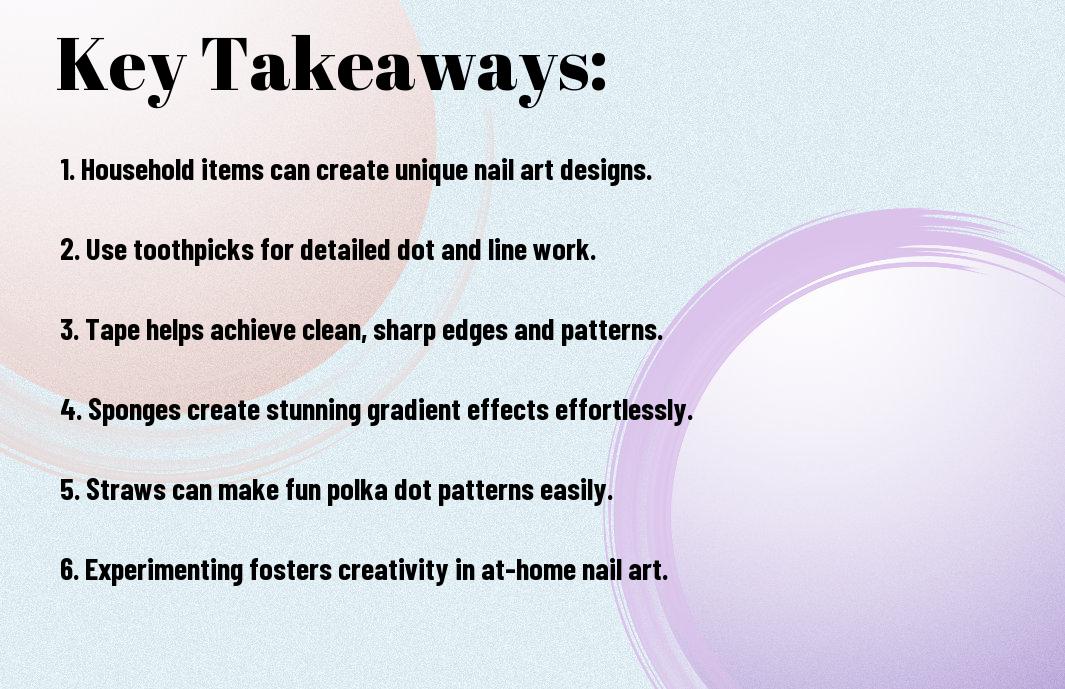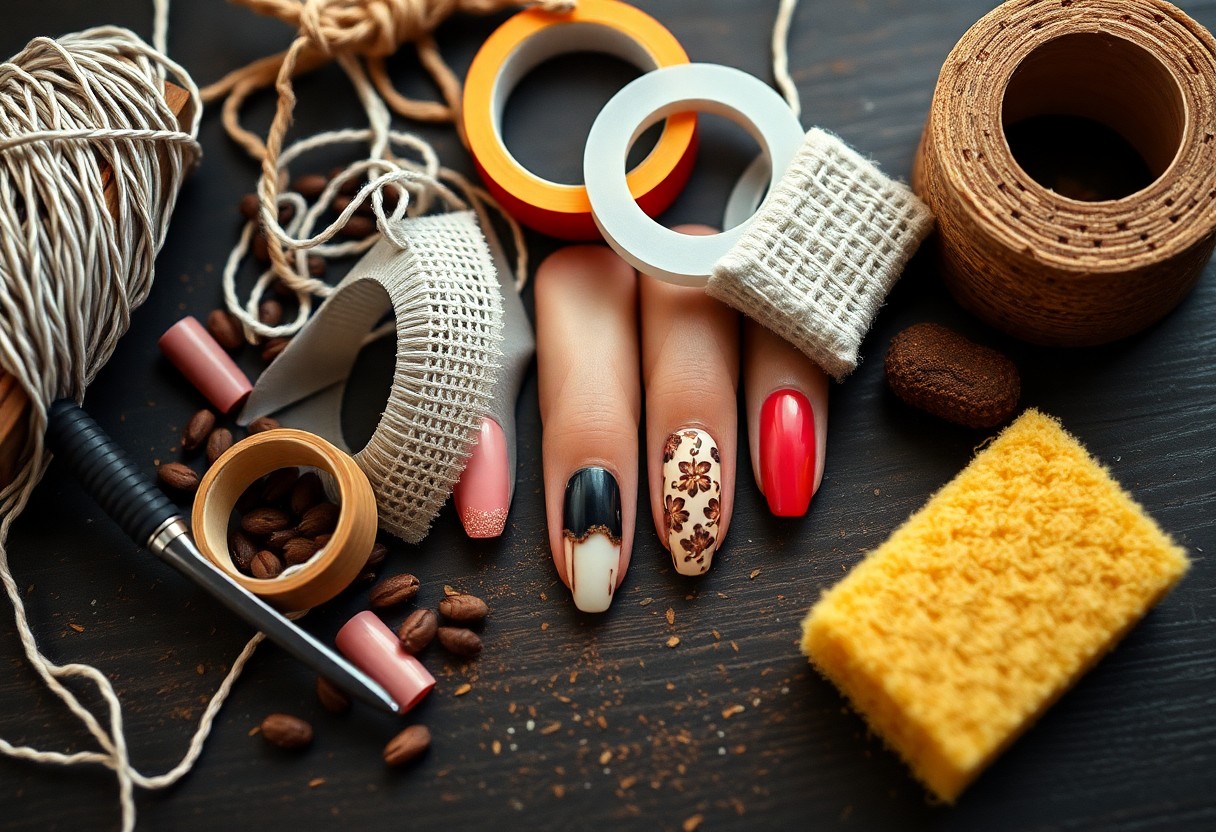Nail art doesn’t have to be expensive or require professional tools; you can unleash your creativity using everyday household items. From rubber bands to tape, the possibilities are endless when it comes to achieving stunning designs right at home. In this post, you’ll discover various techniques and items you can use to elevate your nail game without breaking the bank. Get ready to transform your nails with what you already have in your beauty arsenal!
Key Takeaways:
- Creativity is key: Household items like plastic bags, sponge, and tape can be used to create unique nail art designs.
- Accessibility: You don’t need expensive tools or products; everyday materials can help achieve beautiful nail art.
- Experimentation: Trying out different techniques with common items can lead to innovative and fun nail art styles.

Exploring Household Items for Nail Art
To unleash your creativity, exploring household items for nail art can transform your manicures into mini masterpieces. With just a few everyday products, you can achieve intricate designs that rival salon quality. From kitchen supplies to crafting tools, you’ll be amazed at the resources available right at home. Embrace the DIY spirit, and let your imagination run wild as you discover how to use these common items to elevate your nail art game.
Common Kitchen Supplies
Across your kitchen, you can find a treasure trove of supplies that can be used for stunning nail art. Items like toothpicks, sponges, and even plastic wrap can help you create unique patterns and textures. Using a simple sponge, for instance, allows you to dab on colors for an eye-catching ombre effect, while toothpicks can be utilized for fine detailing. By looking around your kitchen, you can easily access tools that enhance your nail artistry without spending a dime.
Crafting Tools and Their Uses
Below, you’ll discover that various crafting tools can elevate your nail art skills significantly. Items such as paintbrushes, dotting tools, and scissors can create intricate designs that showcase your artistic side. Craft paint and nail tape can also be utilized to achieve sharp lines and fun embellishments, adding that professional touch you desire. The beauty of using crafting tools is that they are readily available, and with just a bit of creativity, they can make your nail designs stand out.
At home, you likely have an assortment of crafting tools that can be repurposed for nail art. For example, paintbrushes can be used for detailed line work, while dotting tools are perfect for creating polka dots or intricate designs. Additionally, craft scissors can assist in achieving clean edges when working with tape or stickers, while old makeup sponges can help you blend colors seamlessly. By utilizing these tools creatively, you can experiment with various techniques to enhance your nail art projects effectively.
Techniques for Nail Art with Household Items
Clearly, you can unleash your creativity by using various techniques for nail art with household items. From using a simple toothpick to create intricate designs to utilizing tape for crisp lines, the options are limitless. If you’re unsure where to begin, check out Where to start with DIY nail art? : r/RedditLaqueristas for some inspiration and tips!
Stamping and Printing Methods
Above all, stamping and printing methods can create stunning designs on your nails effortlessly. You can use everyday items like sponge applicators or kitchen sponges to apply polishes and create eye-catching patterns. By experimenting with different objects around your home, you’ll achieve unique looks that stand out.
Creating Patterns and Designs
About your patterns and designs, there are several innovative techniques to explore. Using brushes, dots, or even straws can help you achieve various effects and textures that elevate your nail art game.
It’s beneficial to practice creating patterns with objects like old toothbrushes, forks, or even the ends of your makeup brushes. Each household item can offer a different texture and look, allowing you to explore your artistic side. Experimenting with various colors and layering techniques will inspire you to develop a unique style that reflects your personality and taste.
Safety and Precautions
Despite the fun of experimenting with nail art, it’s important to prioritize safety and precautions. Always keep your workspace clean and ensure proper ventilation when using any household materials. For ideas on getting started, check out 8 nail art designs you can DIY at home with limited tools … to inspire your creativity without compromising safety.
Ensuring Non-Toxic Materials
The materials you use for nail art should be non-toxic and safe for your skin. Look for products that are labeled as free from harmful chemicals. Common household items such as food coloring, hand sanitizer, and vinegar can often serve as effective alternatives to commercial nail art supplies.
Avoiding Skin Reactions
The potential for skin reactions should always be taken seriously. Pay close attention to how your skin reacts to various materials, especially if you have sensitive skin or allergies. Always perform a patch test on a small area before applying any item directly to your nails or cuticles. If you notice any irritation, discontinue use immediately.
Skin reactions can range from mild redness and irritations to allergic responses. It’s wise to avoid using items like glue, paint, or chemicals not meant for nail use. Always assume that any material could cause a reaction, especially if you are trying something new. Being cautious can help you enjoy your DIY nail art experience without any discomfort.
Tips for Successful Nail Art
Now, to elevate your nail art game, keep these tips in mind:
- Start with a clean canvas – ensure your nails are dry and free from polish.
- Use thin layers of polish for better control and quicker drying.
- Experiment with different household items to create unique designs.
- Be patient and allow each layer to dry properly.
Recognizing the importance of practice will help you improve your skills over time.
Preparing Your Nails
Any successful nail art starts with proper nail preparation. Clean your nails thoroughly, shape them to your desired length, and push back cuticles for a polished look. It’s vital to apply a base coat to shield your nails from staining and to create a smooth surface for the art.
Finishing Touches and Top Coats
Before showcasing your beautiful designs, finish with a top coat to seal in your artwork. This step adds shine and helps prevent chipping, ensuring your nail art looks fresh for longer.
Another important aspect of finishing touches is the careful application of your top coat. Use smooth, even strokes to avoid disturbing your design. This clear coat not only enhances the shine but also provides a protective layer, allowing your creativity to stand the test of time. Additionally, consider using a quick-dry top coat if you’re in a hurry; it will help speed up the final drying process without sacrificing quality.

Creative Ideas and Inspiration
Your journey into household nail art can be both fun and fulfilling. Explore everyday items—like coffee filters for a tie-dye effect, or scotch tape for geometric patterns—to unleash your imagination. The possibilities are endless; from simple polka dots to intricate designs, let your creativity shine through. Plus, don’t hesitate to mix and match techniques for a truly unique look that reflects your personal style.
Seasonal and Themed Designs
Against the backdrop of each season, you can create stunning themed nail designs using items from home. For instance, in autumn, leaves can inspire warm color palettes, while winter can evoke thoughts of snowflakes and icy blue hues. By incorporating these elements, your nails can embody the spirit of each holiday or celebration, making your artistic expression timely and relevant.
Social Media Trends
Seasonal nail art often finds inspiration from trending designs across platforms like Instagram and TikTok. Creative influencers showcase innovative techniques that can spark your imagination. By keeping an eye on these trends, you can not only stay relevant but also make use of household items to replicate popular styles.
Social media’s influence on nail art trends encourages you to engage with a community of enthusiasts and experiment with viral designs. You can find tutorials on how to create vibrant ombre effects with kitchen sponges or patterned prints with plastic wrap. By participating in these trends, you not only enhance your skills but also connect your creations with a broader audience. Whether you’re trying out the latest nail hacks or sharing your own, social media platforms are a valuable resource for inspiration and ideas.
Final Words
With these considerations in mind, you can effectively create stunning nail art using everyday household items. Explore your creativity by utilizing tools like toothbrushes, sponges, or even plastic wrap to achieve unique designs. Experimenting at home allows you to personalize your nail art without the need for expensive supplies. By using common objects, you not only save money but also embrace a fun, DIY approach to beauty. So gather your household items and transform your nails into a canvas for your artistic expression.
FAQ
Q: Can I really use household items for nail art?
A: Absolutely! Household items can be a fantastic resource for creating unique nail art. Items like toothpicks, sponges, tape, and even kitchen utensils can be utilized to achieve a variety of designs, from dots to stripes and more intricate patterns.
Q: What common household items are best for making nail art?
A: Some of the best household items for nail art include:
– Toothpicks: Perfect for detailed designs or dotting.
– Sponges: Great for creating gradient effects.
– Tape: Helps in making clean lines or geometric designs.
– Old makeup brushes: Useful for painting techniques or adding finesse.
– Paper clips: Can be bent into various shapes for unique nail decorations.
Q: How can I clean up after using household items for nail art?
A: Cleaning up after your DIY nail art is easy. For items like sponges or brushes, simply wash them with soap and water. For sticky tape residue, a bit of nail polish remover applied to a cotton ball can help clean surfaces. Always ensure to work on a covered surface to make cleanup simpler.
Q: Are the designs made with household items durable?
A: The durability of nail art using household items largely depends on the type of nail polish used, as well as the top coat application. Using high-quality nail polish and a strong top coat will help your designs last longer, regardless of whether you used professional tools or everyday items.
Q: Can I create intricate designs with household items?
A: Yes, you can create intricate designs with household items! While it may take a bit more practice and creativity, you can achieve complex patterns using tools like toothpicks for detail work or sponges for textured backgrounds. The key is being patient and experimenting with different techniques to find what works best for your style.
